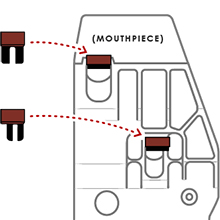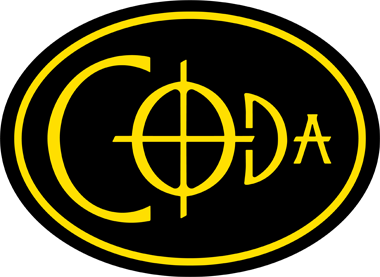Frequently Asked Questions
Yes!
Completely?
Yes! We mold the components for our Coda EDC Flutes in the USA using a tough, precision-molding, food safe, medical-grade plastic. Right here in Connecticut, we carefully assemble them ourselves (using both adhesive and ultrasonic welding) and perform all our other secondary operations.
There are many types of flutes in the world: https://en.wikipedia.org/wiki/Flute
Both recorders and Coda EDC Flutes are considered duct flutes, or fipple flutes. However, while the recorder is a tubular duct flute…
Coda belongs to an ancient family of musical instruments known as vessel flutes, or globular flutes, dating back several thousand years. Today, different types of vessel flutes go by many names around the world: gemshorn, xun, ocarina, hun, tsuchibue, etc.
Is Coda an Ocarina?
Well, Coda is a unique type of vessel flute. Ocarinas are also vessel flutes. So, it’s up to you.
After laboring for years to develop Coda, I chose not to call it an ocarina for a few reasons.
1st, Coda doesn’t look like any existing ocarinas because it was painstakingly designed with EDC in mind. (EDC means EveryDay Carry.) In practical terms, single ocarinas of similar pitch to Coda are still a bit larger and heavier than Coda even though they have much less range. Double ocarinas do have the range of Coda, but they are significantly larger and heavier, which makes them unsuitable for everyday carry. Coda’s combination of two chromatic octaves with full sound, and tough, light portability makes it unlike any ocarina.
2nd, Coda’s interior chamber design is unlike that of existing ocarinas, which allows it to have a wide range and big sound with a surprisingly small footprint.
3rd, Coda’s patented Uni-Phi™ tone holes are unique. They were designed to allow a more intuitive, fluid fingering pattern than those used by double chamber ocarinas. For instance, Coda uses only one set of toneholes to play both the upper and lower chambers, and you can use the same fingerings to play the 2nd diatonic octave as you do to play the 1st. In contrast, on a double ocarina you have to slide your right hand fingers back and forth between two separate sets of tone holes, and the fingerings for the 2nd diatonic octave are completely different than those of the 1st. (Of course, if you already play a double ocarina really well, you may prefer what you are used to.)
My Background Making Vessel Flutes
I first became smitten with vessel flutes nearly 25 years ago when I purchased a tiny clay ocarina from a Honduran street vendor in Boston. That particular instrument was musically limited and far too fragile, but it inspired me to see the potential of a take-along flute, one that could fit into adult life and accompany me on my adventures.
Eventually, I left teaching to start prototyping and then manufacturing my own tiny, tough vessel flutes: Mountain Ocarinas. They were wonderful, but –as a musician– I always wanted a bit more range than only an octave and a third.
Skipping forward a couple of decades…
Coda EDC Flutes are the long-term result of pursuing a clear goal:
- to create a true everyday carry flute
- with intuitive fingering
- and great sound
- across two chromatic octaves (C5 to C7, plus).
And Finally… How Does Coda Compare to a Recorder?
Coda’s simple linear fingering pattern is similar to that of the recorder and to the rest of the woodwind family. However, Coda is only 5 inches long (12.7 cm), so you can easily bring it along with you. In contrast, soprano recorders are usually about 12.5 to 13.25 inches long (31.75 to 33.655 cm).
Furthermore, the recorder’s lowest notes tend to be very quiet (you get drowned out when playing with other musicians), whereas the uppermost notes are very loud. In contrast, Coda’s lower octave is strong, and the upper octave is not louder than the lower.
The Foreign Service Institute ranks foreign languages based on the average time it takes native English speakers to reach “Professional Working Proficiency.” They have found that it takes much less time to attain that level of proficiency in Spanish than it does in Japanese. (Keep in mind that learning depends on many factors, such as interest, time, dedication, learning methods…)
Similarly, every musical instrument has a learning curve. Some instruments take less time to get up and running than others. I think of this as functional proficiency. How long does it take before you are ready to play songs for others, before you can make music that you are proud to share?
In this context, Coda EDC Flutes have several attributes that make them relatively easy to learn compared to most musical instruments.
For example, beginners will likely play simple songs –like “Hot Cross Buns,” etc.– from their first session. And you’ll progress MUCH faster on Coda than you would on, say, a trumpet, saxophone, or flute.
If you’re already an active musician, you’ll get rolling on Coda surprisingly fast.
Of course, Coda’s sound (your sound) will improve dramatically over time, growing ever more beautiful as you gradually master the nuances of proper breath control and technique. As with any serious musical instrument, you could spend a lifetime growing and improving your skills.
To read more about why Coda is relatively easy to learn, go here.
We mold the components for our Coda EDC Flutes in the USA using a tough, precision-molding, food safe, medical-grade plastic. Here in Connecticut, we carefully assemble them ourselves (using both adhesive and ultrasonic welding) and perform our other secondary operations.
(By the way, since COVID-19 has people asking about this, you can disinfect your flute by wiping it with isopropyl alcohol. Alcohol will not hurt Coda. We’ve already done this to each and every Coda before we ship one to you.)
Coda only weighs 2.4 ounces and is very tough. For instance, I have mine on me ALL THE TIME, clipped to my left front pants pocket while working, hiking, running, going to the grocery store… I play Coda out in the woods, up in the mountains, etc., virtually every day, in sunshine or rain, in summer heat or freezing cold. Although it appears slightly polished from much handling, my well-used Coda looks great.
During the testing phase, I literally threw dozens of Codas against a concrete shop floor over and over to try to break them. After hard impact on concrete, they’d often get little dents but still play fine. It really took some work to get one to fail.
Unlike most instruments, even most portable ones, Coda is designed to bring along and play wherever you go. You don’t have to baby it!
Below, I have included part of our guarantee. (We also have a 70-Day Satisfaction Guarantee.)
365-Day Guarantee
Since Coda is an everyday carry flute, we want you to feel confident about bringing it with you through life. Therefore, we also provide a 365-day replacement guarantee against ACCIDENTAL breakage (i.e., not on purpose) if you buy directly from CodaEDC.com. If within those 365 days, your Coda is accidentally damaged in such a way that it no longer plays correctly, we will replace it free of charge.
–Karl Ahrens
In other words, how many notes do Coda EDC flutes play?
Coda plays two chromatic octaves, from C5 to C7 (plus a few notes below C5 that you can access using a special technique).
An octave is the eight notes of a major scale: do, re, mi, fa, sol, la, ti, do. (Note that do is repeated.) Coda plays two of those:
C – D – E – F – G – A – B – C – D – E – F – G – A – B – C
Chromatic means that Coda plays ALL the sharps and flats in between:
C – C#/Db – D – D#/Eb – E – F – F#/Gb – G – G#/Ab – A – A#/Bb – B –
C – C#/Db – D – D#/Eb – E – F – F#/Gb – G – G#/Ab – A – A#/Bb – B – C
In fact, with some practice using a special technique, you’ll eventually be able to add two or three more notes below Coda’s low C.
Why is a range of two chromatic octaves important? With two full chromatic octaves, you can reach all the notes in your favorite songs, you can join in with other musicians, you can improvise freely, and you have plenty of range for composing on the go.
All that in the palm of your hand!
With everyday carry in mind, Coda has been carefully engineered to keep it durable, compact, and light.
- Length: 5 inches, or 12.7 cm, from head to tail
- Width: 2.33 inches, or 5.9 cm, at widest point
- Thickness at Head: 1.25 inches, or 3.175 cm
- Thickness at Tail: 0.9 inches, or 2.29 cm
- Weight: 2.4 ounces
- Weight with Coda Clip: 2.6 ounces
Note: Coda Silencers, which store onboard Coda, are too light to be registered by our postal scale.😄
There were a few factors. When you work on something for a long time, you want even the name to mean something.
First, there’s the descriptive acronym: Compact Optimized Dual Aerophone.
Secondly, I liked the name. Easy to say in many languages, like the name of a friend, a musical companion. Lastly, “In music, a coda (Italian for “tail”) is a passage that brings a piece (or a movement) to an end.” https://en.wikipedia.org/wiki/Coda_(music) For me, Coda is the end result of a long pursuit… and the beginning of the next movement.
Here is a link to cleaning and caring for Coda EDC Flutes: https://codaedc.com/care-and-cleaning/
Because of how the Coda Clip is designed and carefully attached, it doesn’t affect the sound of the flute.
If you decide that the Clip is not useful to you, can you take it off?
Yes, you can. Although we attach the Clip with tough 3M VHB tape (which holds up really well), you can remove the Clip. Simply hold Coda firmly in one hand and work the Clip side to side with your other hand until it* comes off. (*The Clip, not your hand!😉) The Clip and tape will come off cleanly without damaging Coda.
Can you reattach the Clip? Well, yes, you can, but you’d have to ask us for a new piece of specially-cut 3M VHB tape. How to Attach a Clip to Your Coda.
Absolutely!
Since you’ll have Coda with you at times and in places where there’s no sheet music in sight, you’ll likely wind up learning to play by ear, if you haven’t already.
After that, you naturally start improvising, making up your own music on the fly, which is a wonderful way to relax. From improvisation, new songs flow, and you can jot down the notes as you go.
For example, you’re trying to keep yourself awake on a road trip, so you start to improvise vocally. You sing a phrase or make up a tune that really grabs you, so you record it into your phone. Of course, the hope is that maybe you’ll get around to transcribing the tune on your piano some day, if you remember. But what if you could pull over right then and there and pick that tune out on Coda before you lose the inspiration, the excitement, the energy! Don’t wait! Jot it down right away on the back of an old receipt or in your pocket notebook. And boom! You’ve made a giant leap forward toward a finished creation.
Great ideas come to us. Remembering them –capturing them before they flit away– is the challenge. Completely portable with a range of more than two chromatic octaves, Coda can help.
In other words, is Coda the kind of instrument that you will feel proud to play in front of others?
Yes! And no!
As I’m out in the world playing Coda, people have spontaneously come up to me to express just how beautiful it sounds. There have even been rounds of applause from total strangers. Friends have had similar experiences. (There is nothing quite like the haunting sound of a flute wafting on a summer breeze.)
BUT will Coda sound beautiful the first time you play it? Well, not likely. Let’s say that you have never played a violin, and I lend you my priceless Stradivarius. (No problem! I have 6 of ‘em up in the attic.😉) With eager anticipation, you carefully draw the bow across the strings: “Scr-e-e-e-e-ch!”
Is there something wrong with the violin? No. In experienced hands, it would sound beautiful. You just need some time and practice before you unlock the beauty trapped within the instrument. Most instruments are like that.
The good news is that you will get up and running on Coda MUCH faster than on many instruments like the guitar, saxophone, clarinet, concert flute, etc.
But keep this in mind. Even though you’ll be able to play simple songs on Coda right from the start, your sound will improve dramatically over time, growing richer, clearer, and more beautiful as you master the nuances of proper breath control and technique.
Here are some Coda sound samples:
To hear more performances on Coda EDC Flutes, visit our youtube channel.
There are a few issues that affect tuning.
Don’t Cover the Tuning Hole
Be sure to use your right thumb to cover the right thumbhole and not the tuning hole. (See the picture below.) If you cover that tuning hole on the bottom of Coda, the upper chamber will sound much lower in pitch than it should. By the way, don’t worry about covering that tuning hole by accident. It only happens when beginners –bless their hearts– mistakenly do it on purpose.🙂 Note: If you have a Clip on your Coda, it’s impossible to make this mistake.

Completely Covering Tone holes
If both sides of the divided tone holes are not completely covered with your finger pads, then the pitch will sound a little higher than it should. When you are new to Coda, you may have a little trouble consistently sealing the tone holes. Don’t worry. With a little practice, you’ll soon get the hang of this.
Note: The inner “half” of each divided tone hole controls the upper sound chamber. The outer “half” controls the lower sound chamber.
Blowing Pressure Affects Pitch
Be aware that blowing pressure affects tuning. Pitch rises when you blow harder and falls when you blow softer. If you blow too gently on the lowest notes (the way you are forced to play low notes on many recorders, tin whistles, and ocarinas), your lowest notes on each sound chamber will sound flat. For that reason, be sure to support the lowest notes on each chamber with sufficient blowing pressure.
For a more thorough discussion of tuning, go here.
(Or For Whom Did I Design Coda?🙂)
In a nutshell: Mature Musicians Missing Making Music
I designed Coda to be an instrument worthy of serious dedication but also tiny and durable enough to fit into a busy adult’s life. So…
Maybe you played an instrument as a kid, but it fell by the wayside when you left the nest. Now you miss it.
Maybe you always longed to play an instrument, but somehow it never worked out.
Maybe you currently play one or more instruments, but you can only play at certain times and in a specific room.
Maybe you’d like an instrument to bring along when you head out into the wild.
Maybe you’d like to compose when inspiration hits you and not only when you’re seated in front of a keyboard.
Maybe you’d just love the freedom to play wherever you are, whenever you have a minute.
If any of that is what you are looking for, then perhaps Coda is for you, whatever your age.
(Pssst! A big challenge for many musicians is how to practice on the hush-hush — without bothering others. Coda Silencers let you practice quietly.)
Maybe it is. If something isn’t that valuable to you, then it definitely costs too much! But…
Here’s another perspective on price.
We are a small family-owned business that has made many sacrifices to develop and produce our own unique products here in the USA. Unfortunately, we don’t yet benefit from the economies of scale enjoyed by large corporations. Also, you’d probably be surprised by the amount of hand labor that goes into our products at this point, such as hand trimming, gluing, drilling, welding, sanding, testing, disinfecting, etc. (And obviously, many goods sold in the US are produced in immense overseas factories where costs are much lower.)
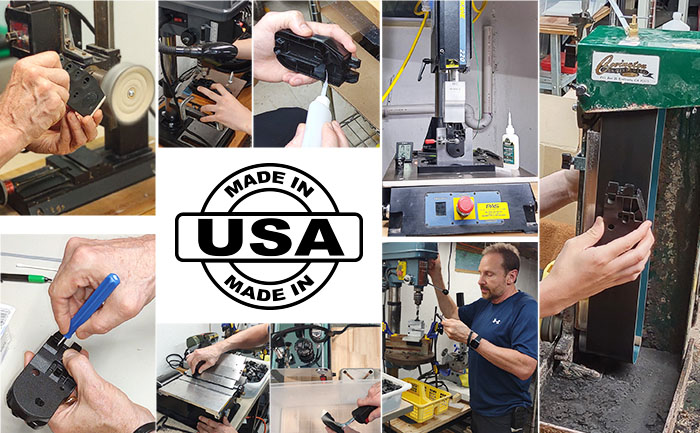
For those of you unfamiliar with the costs of bringing a product like Coda to the market, here’s a small taste:
If you have trouble consistently covering all the tone holes at first, don’t worry! It’s very common, but –with practice– it soon stops being an issue.
Here are a couple of pictures and a few tips.
First, my wife just took a couple quick pictures of me holding Coda to show you what that looks like. My fingers are relaxed, and I am covering the tone holes with the pads of my fingers rather than the finger tips. You’ll notice that my fingers are more or less in line with the tone holes as opposed to being angled up or down.
Also, notice that each tonehole is divided into two “halves,” so be sure to cover both halves of each bisected tonehole. The outer half controls the lower chamber, and the inner half controls the upper chamber.
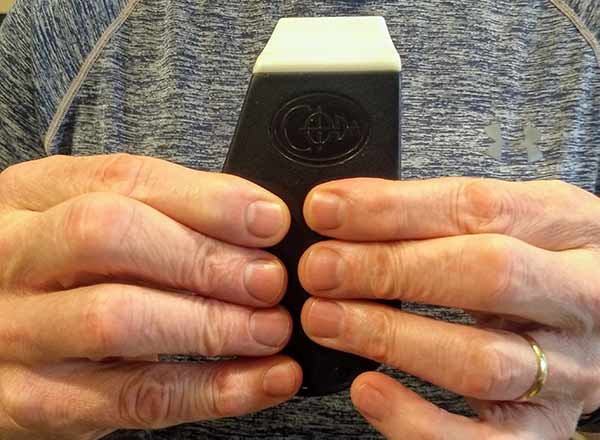
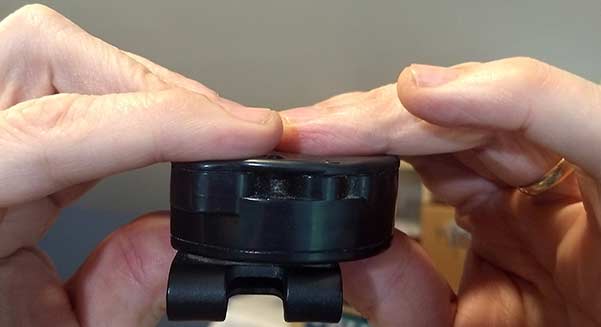
Eventually holding Coda will feel very natural, as if it’s an extension of your hands. But at first, it can feel awkward. After all, the entire instrument is only 5 inches long. A way to quickly get your fingers used to holding Coda is by doing what I call Silent Fingering Exercises. I do these with my feet up while watching a movie with my family, etc., and it’s one of the many advantages of an EDC (everyday carry) instrument.
How To Do Silent Fingering Exercises: Hold Coda up to your lips, or at chest level, but don’t blow. Instead, just walk your fingers up and down the scale, one octave or both octaves, over and over, in sort of an absentminded way. If you’re like me, you’ll EVENTUALLY come up with all sorts of productive fingering gymnastics that later pay off when you play Coda. For instance, you can practice scales, difficult fingering transitions, sharps and flats, challenging ornaments, whatever you can think of, while you watch a movie. It’s surprisingly helpful for developing the necessary muscle memory, which helps you to “become one with your instrument.”
Here’s another thing you can do if you feel frustrated at first about not always covering the tone holes completely. Start out with simple songs. For instance, try our free Self-Learning Music Curriculum here: https://codaedc.com/smc/ (or at least the simpler songs included on the pamphlet with your Coda). By starting with simple three note songs and then adding one new note at a time, you can isolate which holes you’re not covering completely and quickly self-correct. This is not a bad idea even for more advanced musicians.
Everyone is different, but some folks’ hands feel quickly fatigued when they are in the early stages of playing. This comes from gripping Coda too tightly in an attempt to seal the tone holes. What you’ll discover after a while is that a relaxed grip with correct finger positioning is what works instead of a tight grip, but that too will come with practice.
If it’s specifically the upper chamber that’s giving you a problem at first, here are a couple of suggestions. One, you can play just the lower chamber at first. It has plenty of range to get started. You can add on the upper chamber when you feel confident with the lower chamber. Two, remember that the inner “halves” of the divided tone holes control the upper chamber, so try sliding your finger tips a little more toward the center of Coda if your upper chamber doesn’t sound right.
You know, when I pick up an alto recorder, covering the holes feels very awkward, the distance between some holes is a weird stretch, and I have trouble consistently covering all the tone holes, especially on the low notes. However, I’m sure that if I played the instrument enough my fingers would eventually feel at home. Everyone’s different, but with Coda you may experience something similar.
The Silencers store securely in the specially-designed ribs on the back of Coda, so you are always ready for a little discrete practice.
To store them properly, press the narrow-legged Silencer into the ribs first, and the wider-legged Silencer second.
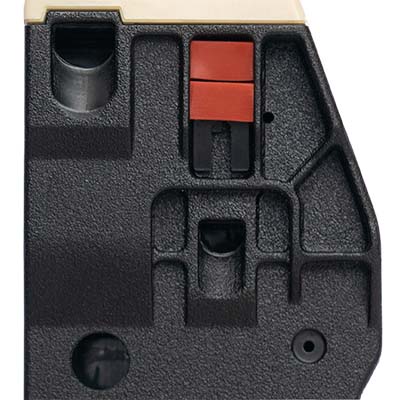
As shown in the picture above, insert the wide-legged Silencer into the larger D-shaped window. The orange pad should point toward Coda’s mouthpiece. Push the Silencer all the way forward toward the mouthpiece.
Then, in the same way, insert the narrow-legged Silencer into the smaller D-shaped window.
